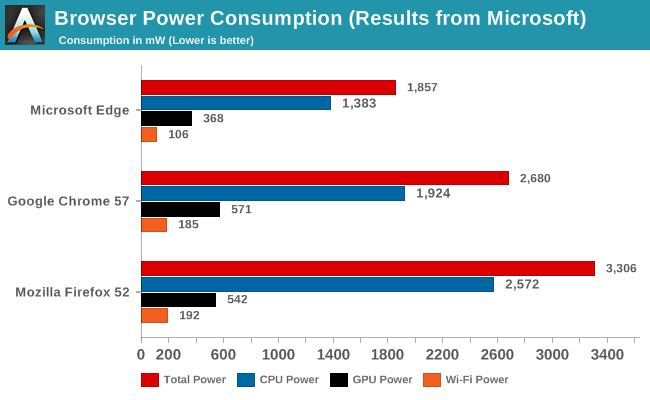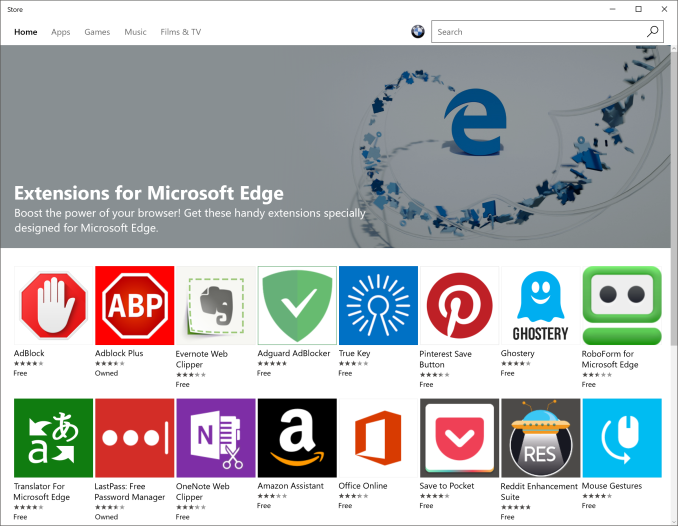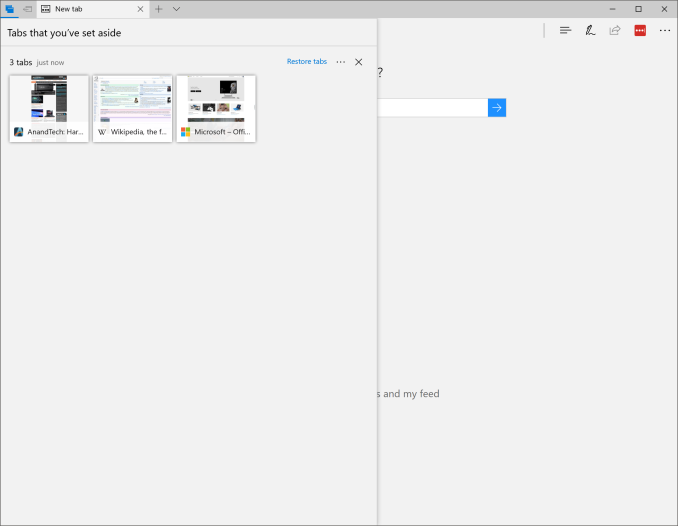The Windows 10 Creators Update Arrives
by Brett Howse on April 25, 2017 8:00 AM EST- Posted in
- Software
- Operating Systems
- Windows
- Microsoft
- Windows 10
Edge Improvements
When Edge launched, Microsoft seemed to have a couple of goals. First, they would dramatically improve security over Internet Explorer, and second, they would drastically improve performance, and keep up the performance improvements over time.
Edge adoption has been very low though. When it first launched, it was lacking a lot of basic features, with important additions like extension support only coming with the Anniversary Update. Extensions was a arguably the biggest single feature missing, and it has been very nice to have a much more capable browser because of this addition, but with low usage share of Edge, coupled with extensions having to be added to the Windows store by the developer, has resulted in there still only being a handful of extensions in the store. At my count, there are 27 extensions, but that might vary based on region. It’s a step in the right direction, and this one change has made Edge much more useful than before.
Edge excels in some areas. Its support for high resolution displays, and its text rendering, continues to be one of its biggest strengths. Performance on scripting is generally quite solid, although it still struggles with pages like Twitter if they are left open for a long time. Microsoft has posted quite a few blog posts about how they have optimized things like scrolling performance with touch, mouse, or keyboards, as well as battery life improvements. Edge has come a long way, and they continue to improve it with every release.
Edge didn’t get anything as big as extensions with this update, but it still got quite a few improvements. The most noticeable is the ability to expand tabs to show the entire page in a mini-window at the top of the screen. This is very similar to how Internet Explorer worked in its touch mode in Windows 8, and can be a useful feature if you are one of those people who keep losing tabs. Also, you can “set tabs aside” which lets you collapse open tabs to the left, where there’s a box to let you open them again. It’s an interesting idea, but in practice it seems to need quite a bit of work. You can’t put individual tabs aside – it’s all or nothing – instantly making it less useful. Also, if you restore a tab from one you’ve put away, and then you close that tab, it’s gone. There’s no way to keep a set of tabs set aside permanently which would be a nice take on favorites. Once tabs are put aside, you can add them to favorites, or share them. The share idea is quite nice, and makes it very simple to share multiple sites with someone in one email. Still, it would be nice to see this fleshed out a bit more.
Microsoft has been touting Edge’s battery life performance for some time now, and they continue to improve Edge to make it more efficient. Their testing methodology is all open-source, which certainly helps with its credibility. According to Microsoft’s measurements, during their tests on identical Surface Book laptops, and averaged over sixteen iterations per browser, Edge used 31% less power than Chrome 57, and 44% less power than Firefox 52. These are significant amounts, and in a power basis, Edge is using under 2 Watts for the same activity that Chrome is using over 2.5 Watts, and Firefox is using around 3.25 Watts. Battery capacity is always going to a be a limit on notebooks, so any efficiency gains are important.

Edge has also gained support for ePub digital books, and WebRTC 1.0 is now on out of the box. There are other small changes like being able to run an .exe file directly rather than having to save it first, and there are some small improvements to PDFs in Edge, and Web Notes.
Also, in the never-ending struggle to remove Flash from the web, Microsoft has made the decision to make Flash click to run in Edge. That means that any page that wants to run Flash won’t be able to, but you can click an icon to enable it. It’s not very obvious, with the icon resembling a puzzle piece, but there is a graphic which shows you what to do the first time it pops up. The results of this change have been mixed, but with browsers moving to disable Flash by default, hopefully that will pressure sites away from using it.
 This puzzle icon means Flash can be enabled for the page
This puzzle icon means Flash can be enabled for the page
Overall, Edge has made some improvements, but nothing huge like in the last update. It needs some more basic functionality added though, such as the ability to view a page source (the debugger tools are overly complex for simple tasks) and it is still far easier to do a lot of tasks in Chrome, which shouldn’t be the case this far into Edge’s existence.












69 Comments
View All Comments
leexgx - Wednesday, April 26, 2017 - link
""Consumers want more features, and sooner, but business needs to test everything before rolling it out.""interesting most people don't give a damn what new version of windows 10 offers, all they are interested in is that what ever browser works so they can do email and other stuff
for most a feature upgrade, this list is a follows
1 application PC settings are reset (browser and associations like PDF and pictures)
2 it uninstalls software without permission that was perfectly working fine (and still works perfectly fine when you reinstall it)
3 can't use there PC for about 2-8 hours when it does the upgrade (slow CPU/RAM/HDD vs SSD)
4 or better a non booting PC (or black screen as some may encounter as they broke the Video WDDM for some old video drivers and it sets the output to 0x0 resolution)
the Fix is use LTSB version if MS wount offer a legitimate LTSB single user licence then how are people supposed to buy it
jabber - Tuesday, April 25, 2017 - link
Just be aware that if you have a mix of Office products say 2010 and 13/16 it will still delete off the latest versions if you do an upgrade. Well done MS, still not fixed that one.Gich - Tuesday, April 25, 2017 - link
it didn't happen to me...I got Office 2007 and 16.
jabber - Tuesday, April 25, 2017 - link
The disappointment for me is that MS is concentrating on adding fluff, bling and bloat I have zero use for but not concentrating on making it more secure, robust and faster. I'd also like a return of the custom install option so I can choose to install that fluff or not.Dave Null - Tuesday, April 25, 2017 - link
Indeed. I finally bit the bullet and installed the LTSB version. This is the lightweight version of Windows I've been looking for.lord_anselhelm - Tuesday, April 25, 2017 - link
Agreed. I also wish they'd focus on fixing bugs they've introduced as a result of updates. For example, Anniversary Update broke centre-alignment of folder/filenames in certain folder views and caused Libraries to start ignoring custom folder views. Both issues still exist in the Creators Update!Gasaraki88 - Tuesday, April 25, 2017 - link
"secure, robust and faster"What does that even mean? How do you even quantify that enough to be worth an update. Do you want them to list that inthe change logs?
herbc - Wednesday, April 26, 2017 - link
Yup , a grossly overbloated OS from the start continues to get worse , my God the idiocy of MS is mind boggling.MutualCore - Sunday, April 30, 2017 - link
Your comment has no substance.fm13 - Tuesday, April 25, 2017 - link
I still can't install this thing - Windows Update seems busted and standalone installer stays stuck on 99% for days.Although Win10 is a nice OS, some things in it seem broken - things that worked flawlessly for years. For example, virus definitions on my system can't update themselves anymore - I have to download and install them manually.
How the hell do you break something like that?